Comprehensive Report: Share Buy-Backs and Financial Implications
VerifiedAdded on 2023/06/07
|6
|1379
|150
Report
AI Summary
This report provides a comprehensive analysis of share buy-backs, a crucial aspect of corporate finance. It begins by defining share buy-backs and their prevalence, highlighting their role in efficient fund utilization and the reduction of issued share capital. The report delves into the reasons companies undertake buy-backs, such as boosting earnings per share and reducing ownership dilution. It then examines the accounting treatment of share buy-backs, including the adjustment of equity components, particularly paid-up share capital and share premium accounts. The report outlines the disclosures required in annual reports and compares share buy-backs with dividend distributions, emphasizing their tax efficiency. Furthermore, it provides example journal entries for buy-back transactions, concluding that share buy-backs are an effective method of utilizing surplus funds and reducing ownership risk. The report references several academic sources to support its analysis, including discussions on the motivations behind share buy-backs, accounting standards, and the impact on shareholder value. The report emphasizes that companies must strive to buy their shares back from the market whenever there is a need for capital reduction or alteration.
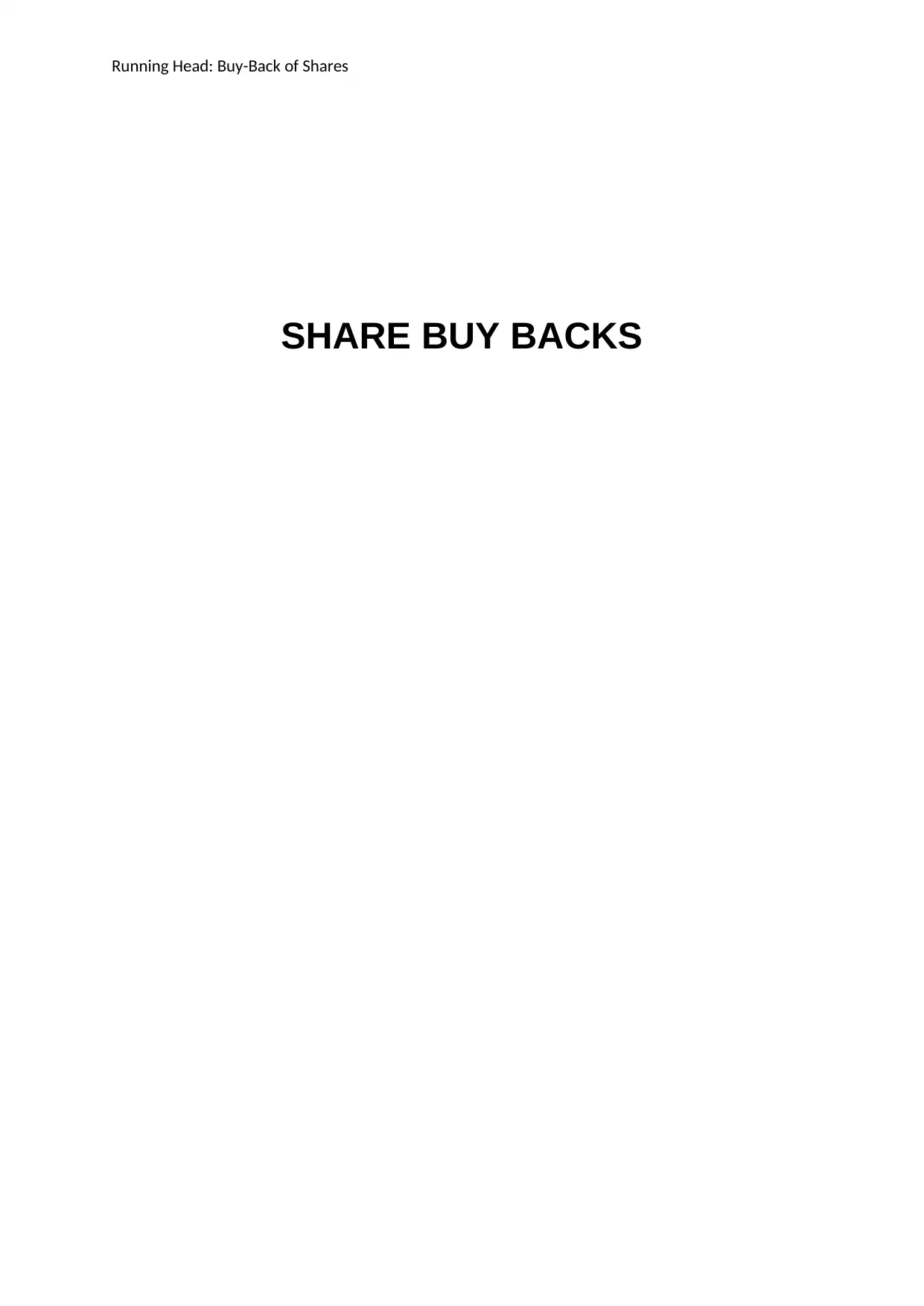
Running Head: Buy-Back of Shares
SHARE BUY BACKS
SHARE BUY BACKS
Paraphrase This Document
Need a fresh take? Get an instant paraphrase of this document with our AI Paraphraser
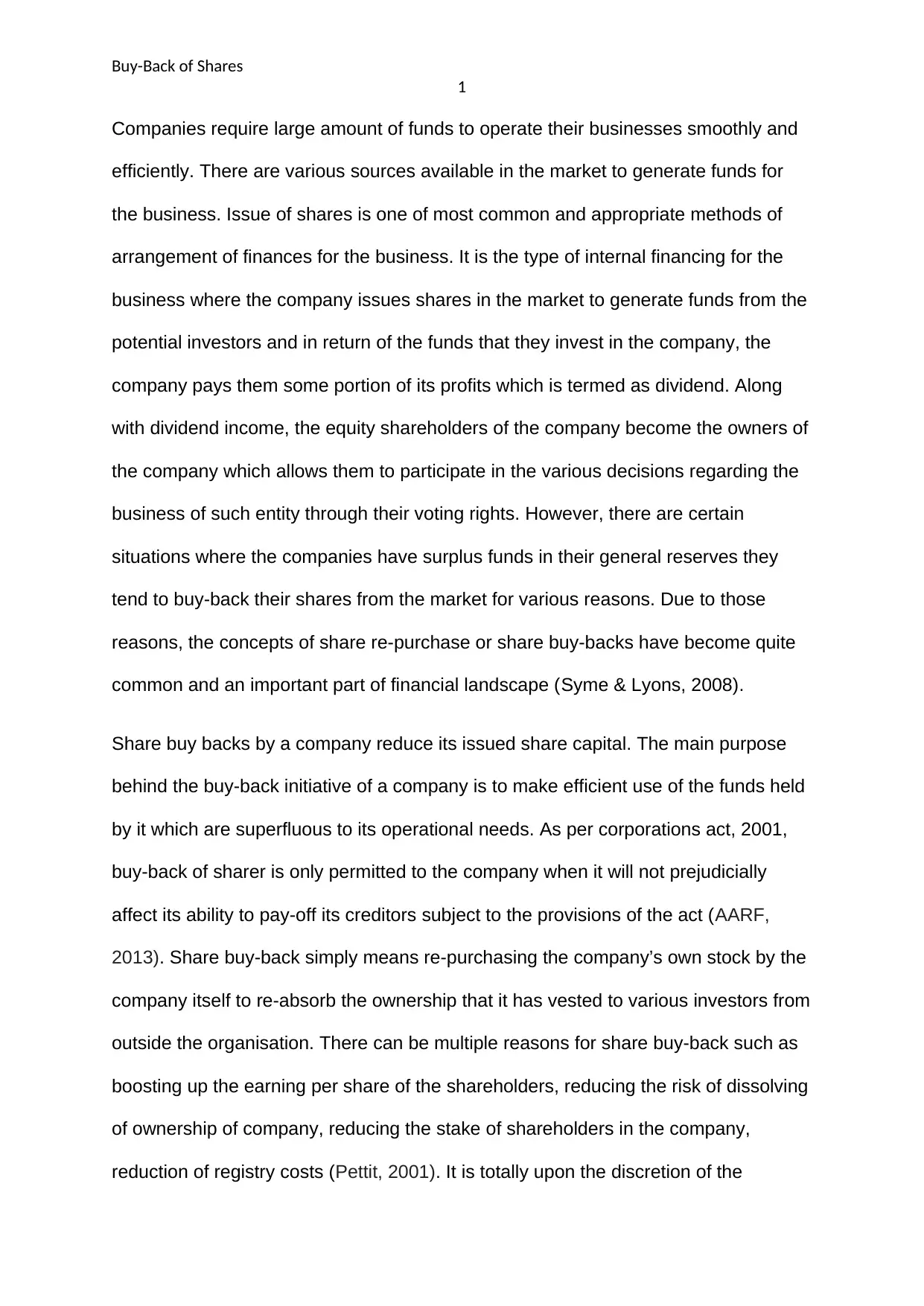
Buy-Back of Shares
1
Companies require large amount of funds to operate their businesses smoothly and
efficiently. There are various sources available in the market to generate funds for
the business. Issue of shares is one of most common and appropriate methods of
arrangement of finances for the business. It is the type of internal financing for the
business where the company issues shares in the market to generate funds from the
potential investors and in return of the funds that they invest in the company, the
company pays them some portion of its profits which is termed as dividend. Along
with dividend income, the equity shareholders of the company become the owners of
the company which allows them to participate in the various decisions regarding the
business of such entity through their voting rights. However, there are certain
situations where the companies have surplus funds in their general reserves they
tend to buy-back their shares from the market for various reasons. Due to those
reasons, the concepts of share re-purchase or share buy-backs have become quite
common and an important part of financial landscape (Syme & Lyons, 2008).
Share buy backs by a company reduce its issued share capital. The main purpose
behind the buy-back initiative of a company is to make efficient use of the funds held
by it which are superfluous to its operational needs. As per corporations act, 2001,
buy-back of sharer is only permitted to the company when it will not prejudicially
affect its ability to pay-off its creditors subject to the provisions of the act (AARF,
2013). Share buy-back simply means re-purchasing the company’s own stock by the
company itself to re-absorb the ownership that it has vested to various investors from
outside the organisation. There can be multiple reasons for share buy-back such as
boosting up the earning per share of the shareholders, reducing the risk of dissolving
of ownership of company, reducing the stake of shareholders in the company,
reduction of registry costs (Pettit, 2001). It is totally upon the discretion of the
1
Companies require large amount of funds to operate their businesses smoothly and
efficiently. There are various sources available in the market to generate funds for
the business. Issue of shares is one of most common and appropriate methods of
arrangement of finances for the business. It is the type of internal financing for the
business where the company issues shares in the market to generate funds from the
potential investors and in return of the funds that they invest in the company, the
company pays them some portion of its profits which is termed as dividend. Along
with dividend income, the equity shareholders of the company become the owners of
the company which allows them to participate in the various decisions regarding the
business of such entity through their voting rights. However, there are certain
situations where the companies have surplus funds in their general reserves they
tend to buy-back their shares from the market for various reasons. Due to those
reasons, the concepts of share re-purchase or share buy-backs have become quite
common and an important part of financial landscape (Syme & Lyons, 2008).
Share buy backs by a company reduce its issued share capital. The main purpose
behind the buy-back initiative of a company is to make efficient use of the funds held
by it which are superfluous to its operational needs. As per corporations act, 2001,
buy-back of sharer is only permitted to the company when it will not prejudicially
affect its ability to pay-off its creditors subject to the provisions of the act (AARF,
2013). Share buy-back simply means re-purchasing the company’s own stock by the
company itself to re-absorb the ownership that it has vested to various investors from
outside the organisation. There can be multiple reasons for share buy-back such as
boosting up the earning per share of the shareholders, reducing the risk of dissolving
of ownership of company, reducing the stake of shareholders in the company,
reduction of registry costs (Pettit, 2001). It is totally upon the discretion of the
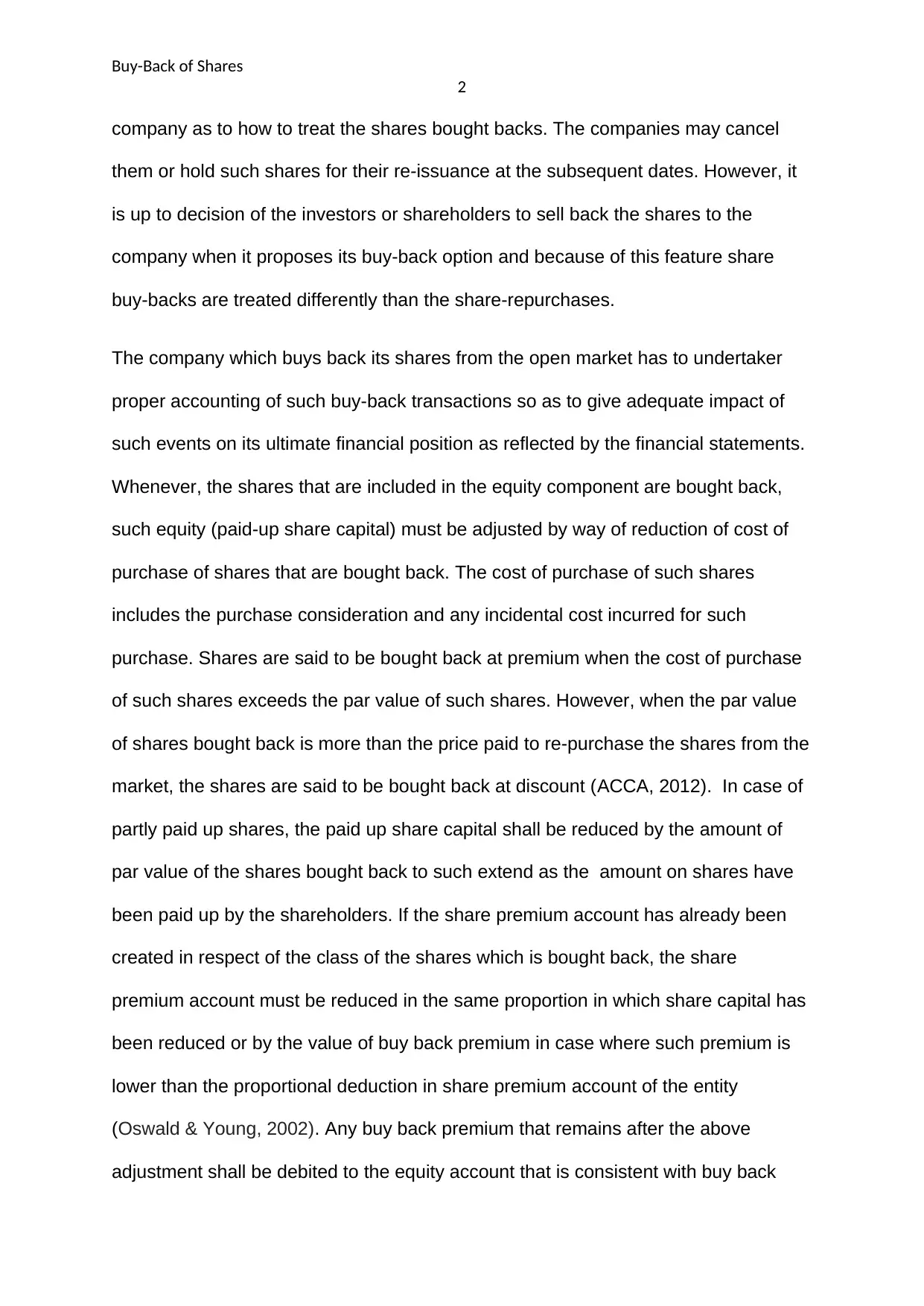
Buy-Back of Shares
2
company as to how to treat the shares bought backs. The companies may cancel
them or hold such shares for their re-issuance at the subsequent dates. However, it
is up to decision of the investors or shareholders to sell back the shares to the
company when it proposes its buy-back option and because of this feature share
buy-backs are treated differently than the share-repurchases.
The company which buys back its shares from the open market has to undertaker
proper accounting of such buy-back transactions so as to give adequate impact of
such events on its ultimate financial position as reflected by the financial statements.
Whenever, the shares that are included in the equity component are bought back,
such equity (paid-up share capital) must be adjusted by way of reduction of cost of
purchase of shares that are bought back. The cost of purchase of such shares
includes the purchase consideration and any incidental cost incurred for such
purchase. Shares are said to be bought back at premium when the cost of purchase
of such shares exceeds the par value of such shares. However, when the par value
of shares bought back is more than the price paid to re-purchase the shares from the
market, the shares are said to be bought back at discount (ACCA, 2012). In case of
partly paid up shares, the paid up share capital shall be reduced by the amount of
par value of the shares bought back to such extend as the amount on shares have
been paid up by the shareholders. If the share premium account has already been
created in respect of the class of the shares which is bought back, the share
premium account must be reduced in the same proportion in which share capital has
been reduced or by the value of buy back premium in case where such premium is
lower than the proportional deduction in share premium account of the entity
(Oswald & Young, 2002). Any buy back premium that remains after the above
adjustment shall be debited to the equity account that is consistent with buy back
2
company as to how to treat the shares bought backs. The companies may cancel
them or hold such shares for their re-issuance at the subsequent dates. However, it
is up to decision of the investors or shareholders to sell back the shares to the
company when it proposes its buy-back option and because of this feature share
buy-backs are treated differently than the share-repurchases.
The company which buys back its shares from the open market has to undertaker
proper accounting of such buy-back transactions so as to give adequate impact of
such events on its ultimate financial position as reflected by the financial statements.
Whenever, the shares that are included in the equity component are bought back,
such equity (paid-up share capital) must be adjusted by way of reduction of cost of
purchase of shares that are bought back. The cost of purchase of such shares
includes the purchase consideration and any incidental cost incurred for such
purchase. Shares are said to be bought back at premium when the cost of purchase
of such shares exceeds the par value of such shares. However, when the par value
of shares bought back is more than the price paid to re-purchase the shares from the
market, the shares are said to be bought back at discount (ACCA, 2012). In case of
partly paid up shares, the paid up share capital shall be reduced by the amount of
par value of the shares bought back to such extend as the amount on shares have
been paid up by the shareholders. If the share premium account has already been
created in respect of the class of the shares which is bought back, the share
premium account must be reduced in the same proportion in which share capital has
been reduced or by the value of buy back premium in case where such premium is
lower than the proportional deduction in share premium account of the entity
(Oswald & Young, 2002). Any buy back premium that remains after the above
adjustment shall be debited to the equity account that is consistent with buy back
⊘ This is a preview!⊘
Do you want full access?
Subscribe today to unlock all pages.

Trusted by 1+ million students worldwide
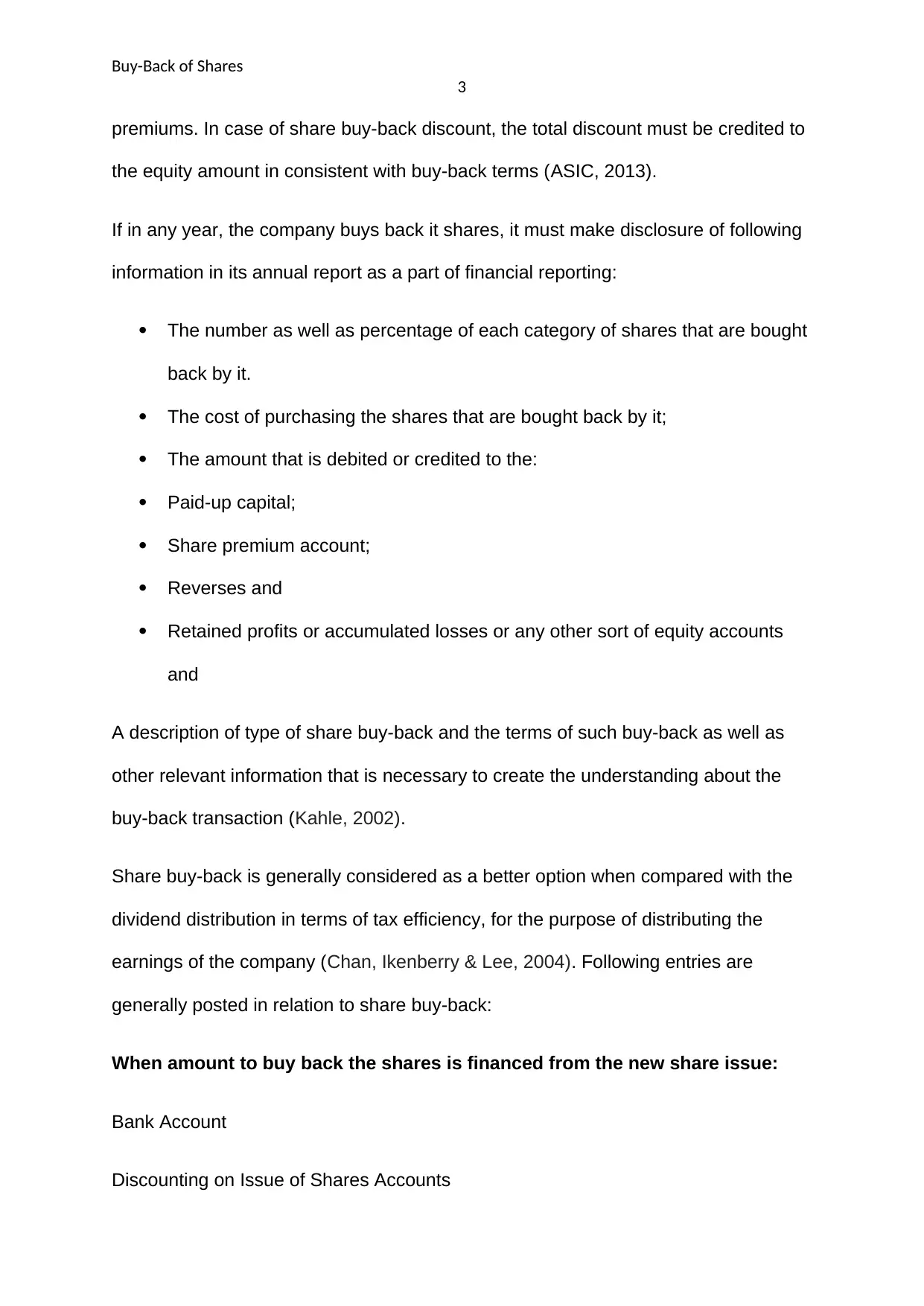
Buy-Back of Shares
3
premiums. In case of share buy-back discount, the total discount must be credited to
the equity amount in consistent with buy-back terms (ASIC, 2013).
If in any year, the company buys back it shares, it must make disclosure of following
information in its annual report as a part of financial reporting:
The number as well as percentage of each category of shares that are bought
back by it.
The cost of purchasing the shares that are bought back by it;
The amount that is debited or credited to the:
Paid-up capital;
Share premium account;
Reverses and
Retained profits or accumulated losses or any other sort of equity accounts
and
A description of type of share buy-back and the terms of such buy-back as well as
other relevant information that is necessary to create the understanding about the
buy-back transaction (Kahle, 2002).
Share buy-back is generally considered as a better option when compared with the
dividend distribution in terms of tax efficiency, for the purpose of distributing the
earnings of the company (Chan, Ikenberry & Lee, 2004). Following entries are
generally posted in relation to share buy-back:
When amount to buy back the shares is financed from the new share issue:
Bank Account
Discounting on Issue of Shares Accounts
3
premiums. In case of share buy-back discount, the total discount must be credited to
the equity amount in consistent with buy-back terms (ASIC, 2013).
If in any year, the company buys back it shares, it must make disclosure of following
information in its annual report as a part of financial reporting:
The number as well as percentage of each category of shares that are bought
back by it.
The cost of purchasing the shares that are bought back by it;
The amount that is debited or credited to the:
Paid-up capital;
Share premium account;
Reverses and
Retained profits or accumulated losses or any other sort of equity accounts
and
A description of type of share buy-back and the terms of such buy-back as well as
other relevant information that is necessary to create the understanding about the
buy-back transaction (Kahle, 2002).
Share buy-back is generally considered as a better option when compared with the
dividend distribution in terms of tax efficiency, for the purpose of distributing the
earnings of the company (Chan, Ikenberry & Lee, 2004). Following entries are
generally posted in relation to share buy-back:
When amount to buy back the shares is financed from the new share issue:
Bank Account
Discounting on Issue of Shares Accounts
Paraphrase This Document
Need a fresh take? Get an instant paraphrase of this document with our AI Paraphraser
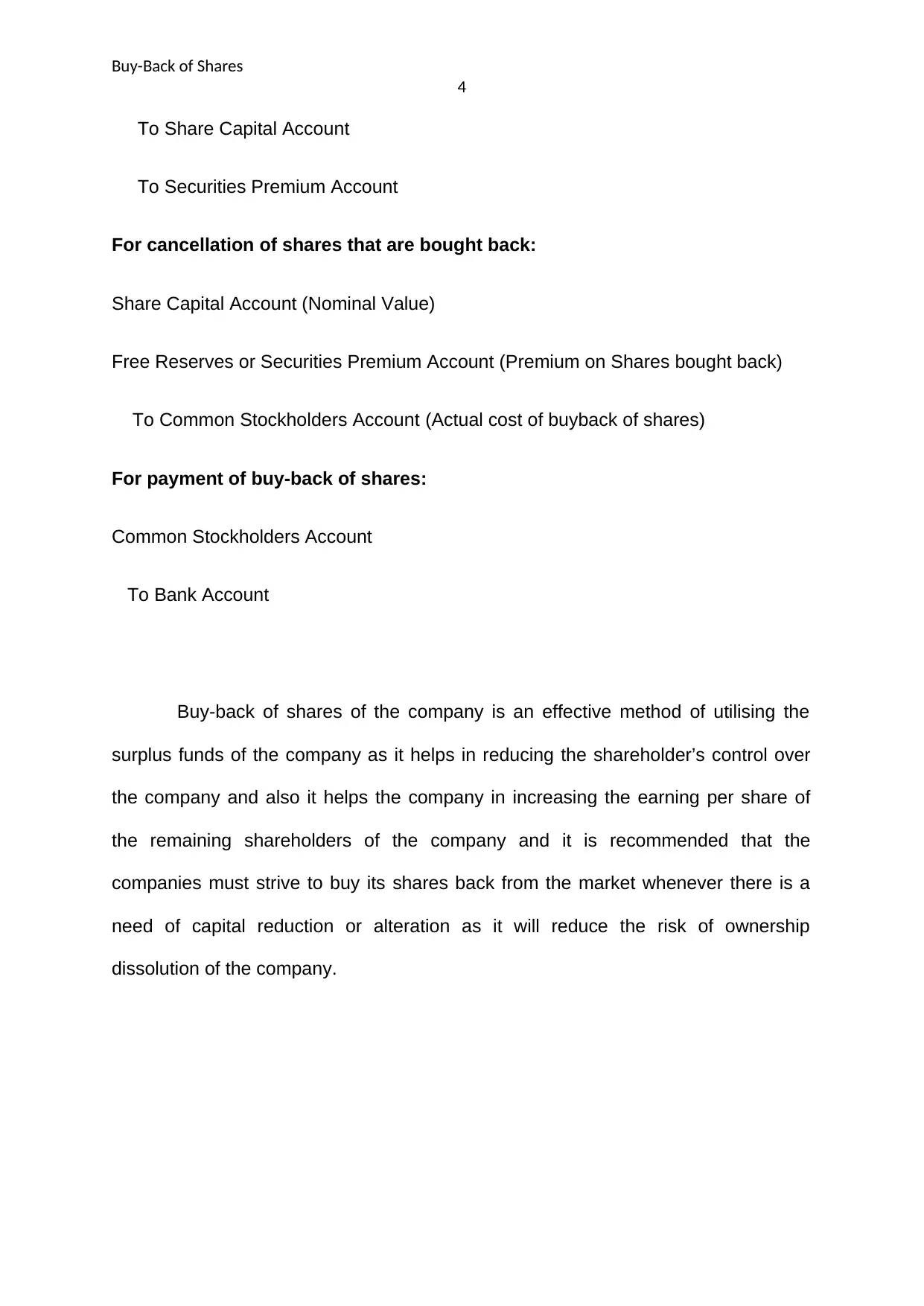
Buy-Back of Shares
4
To Share Capital Account
To Securities Premium Account
For cancellation of shares that are bought back:
Share Capital Account (Nominal Value)
Free Reserves or Securities Premium Account (Premium on Shares bought back)
To Common Stockholders Account (Actual cost of buyback of shares)
For payment of buy-back of shares:
Common Stockholders Account
To Bank Account
Buy-back of shares of the company is an effective method of utilising the
surplus funds of the company as it helps in reducing the shareholder’s control over
the company and also it helps the company in increasing the earning per share of
the remaining shareholders of the company and it is recommended that the
companies must strive to buy its shares back from the market whenever there is a
need of capital reduction or alteration as it will reduce the risk of ownership
dissolution of the company.
4
To Share Capital Account
To Securities Premium Account
For cancellation of shares that are bought back:
Share Capital Account (Nominal Value)
Free Reserves or Securities Premium Account (Premium on Shares bought back)
To Common Stockholders Account (Actual cost of buyback of shares)
For payment of buy-back of shares:
Common Stockholders Account
To Bank Account
Buy-back of shares of the company is an effective method of utilising the
surplus funds of the company as it helps in reducing the shareholder’s control over
the company and also it helps the company in increasing the earning per share of
the remaining shareholders of the company and it is recommended that the
companies must strive to buy its shares back from the market whenever there is a
need of capital reduction or alteration as it will reduce the risk of ownership
dissolution of the company.
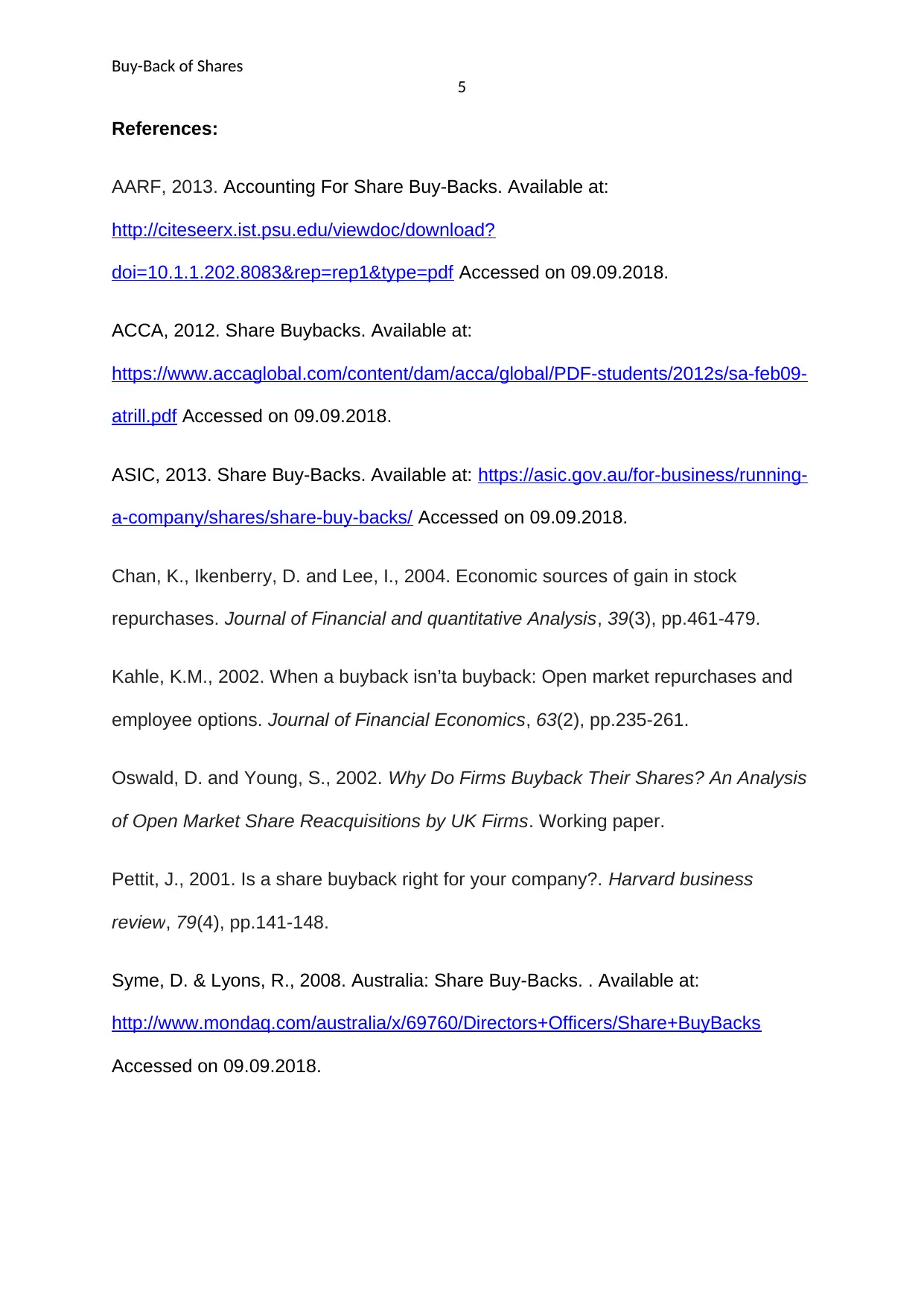
Buy-Back of Shares
5
References:
AARF, 2013. Accounting For Share Buy-Backs. Available at:
http://citeseerx.ist.psu.edu/viewdoc/download?
doi=10.1.1.202.8083&rep=rep1&type=pdf Accessed on 09.09.2018.
ACCA, 2012. Share Buybacks. Available at:
https://www.accaglobal.com/content/dam/acca/global/PDF-students/2012s/sa-feb09-
atrill.pdf Accessed on 09.09.2018.
ASIC, 2013. Share Buy-Backs. Available at: https://asic.gov.au/for-business/running-
a-company/shares/share-buy-backs/ Accessed on 09.09.2018.
Chan, K., Ikenberry, D. and Lee, I., 2004. Economic sources of gain in stock
repurchases. Journal of Financial and quantitative Analysis, 39(3), pp.461-479.
Kahle, K.M., 2002. When a buyback isn’ta buyback: Open market repurchases and
employee options. Journal of Financial Economics, 63(2), pp.235-261.
Oswald, D. and Young, S., 2002. Why Do Firms Buyback Their Shares? An Analysis
of Open Market Share Reacquisitions by UK Firms. Working paper.
Pettit, J., 2001. Is a share buyback right for your company?. Harvard business
review, 79(4), pp.141-148.
Syme, D. & Lyons, R., 2008. Australia: Share Buy-Backs. . Available at:
http://www.mondaq.com/australia/x/69760/Directors+Officers/Share+BuyBacks
Accessed on 09.09.2018.
5
References:
AARF, 2013. Accounting For Share Buy-Backs. Available at:
http://citeseerx.ist.psu.edu/viewdoc/download?
doi=10.1.1.202.8083&rep=rep1&type=pdf Accessed on 09.09.2018.
ACCA, 2012. Share Buybacks. Available at:
https://www.accaglobal.com/content/dam/acca/global/PDF-students/2012s/sa-feb09-
atrill.pdf Accessed on 09.09.2018.
ASIC, 2013. Share Buy-Backs. Available at: https://asic.gov.au/for-business/running-
a-company/shares/share-buy-backs/ Accessed on 09.09.2018.
Chan, K., Ikenberry, D. and Lee, I., 2004. Economic sources of gain in stock
repurchases. Journal of Financial and quantitative Analysis, 39(3), pp.461-479.
Kahle, K.M., 2002. When a buyback isn’ta buyback: Open market repurchases and
employee options. Journal of Financial Economics, 63(2), pp.235-261.
Oswald, D. and Young, S., 2002. Why Do Firms Buyback Their Shares? An Analysis
of Open Market Share Reacquisitions by UK Firms. Working paper.
Pettit, J., 2001. Is a share buyback right for your company?. Harvard business
review, 79(4), pp.141-148.
Syme, D. & Lyons, R., 2008. Australia: Share Buy-Backs. . Available at:
http://www.mondaq.com/australia/x/69760/Directors+Officers/Share+BuyBacks
Accessed on 09.09.2018.
⊘ This is a preview!⊘
Do you want full access?
Subscribe today to unlock all pages.

Trusted by 1+ million students worldwide
1 out of 6
Related Documents
Your All-in-One AI-Powered Toolkit for Academic Success.
+13062052269
info@desklib.com
Available 24*7 on WhatsApp / Email
![[object Object]](/_next/static/media/star-bottom.7253800d.svg)
Unlock your academic potential
Copyright © 2020–2025 A2Z Services. All Rights Reserved. Developed and managed by ZUCOL.





